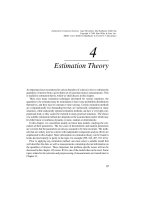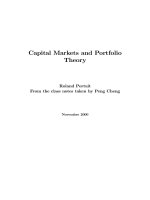portfolio theory review
Bạn đang xem bản rút gọn của tài liệu. Xem và tải ngay bản đầy đủ của tài liệu tại đây (276.73 KB, 18 trang )
Nov, 2013
Wonil Lee, Ph.D. & CFA
CAU
Portfolio Theory Review
Lecture 6
Wonil Lee, CFA & Ph.D.
Diversification and Portfolio
- “Don’t put all your eggs in one
basket”
- Buying a large set of securities can
reduce risk
Development of Modern Portfolio Theory
1950
1952
1964 1966 1972 1977 1992
Conventional
wisdom around
(1950)
Diversification and
Portfolio Risk
(1952)
Single-factor Asset
Pricing Risk/Return
Model (CAPM) (1964)
Efficient Market
Hypothesis
(1966)
Option Pricing Model
(1972)
Database of
Securities Prices
(1977)
3-Factor Model
(1992)
“Portfolio Selection”
•Correlation between risk
and return
•Efficient line
•Small [cap] minus
Large
•High [book/price]
minus low
•Rm-Rf
Technical and basic
analysis established
•Value evaluation of securities
•Measurement of asset price
•Evaluation of performance
Development of derivative
market
“informationally efficient
market”
The EMH states that it is
impossible to consistently
outperform the market by
using any information that
the market already knows
CRSP (The Center for Research
in Securities Prices)
Modern Portfolio Theory
Objective: To obtain the highest return for a given level of risk, or the lowest risk for a target level of
return.
Return
Variance (volatility of individual securities)
Covariance (co-movement of asset prices)
Harry Markowitz – “Portfolio Selection”
- Markowitz proposed that investors focus on selecting portfolios based on their overall risk-reward
characteristics instead of merely compiling portfolios from securities that each individually have
attractive risk-reward characteristics.
- In brief, investors should select portfolios not individual securities.
Derives the expected rate of return for a portfolio of assets and an expected risk measure
Markowitz demonstrated that the variance of the rate of return is a meaningful measure of portfolio risk
under reasonable assumptions
The portfolio variance formula shows how to effectively choose a portfolio
Markowitz Portfolio Theory
Assumptions of Markowitz Portfolio Theory
Investors consider each investment alternative as being presented by a probability distribution of
expected returns over some holding period
Investors maximize one-period expected utility
Investors estimate the risk of the portfolio on the basis of the variance of expected returns
Investors base decisions solely on expected returns and risk, so their utility curves are a function of
expected return and the expected standard deviation of returns
For a given level of risk, investors prefer higher returns to lower returns. For a given level of expected
returns, investors prefer less risk to more risk
Risk and Expected Rates of Return
Definition of Risk
1. Uncertainty of future outcome
2. The probability of an adverse outcome
Beta is a measure of systematic risk
Expected Rates of Return
- Individual Risky Asset: Calculated by determining the possible returns ( R
i
) for some
investment in the future, and weighting each possible return by its own probability (P
i
).
E(R)= ∑P
i
R
i
- Portfolio:
Weighted average of expected returns (R
i
) for the individual investments in the portfolio
Percentages invested in each asset (w
i
) serve as the weights
E(R
port
) = ∑ W
i
R
i
Macroeconomic Factors Affecting Systematic Risk
Variability in growth of money supply
Interest rate volatility
Inflation
Fiscal and Monetary policy changes
War and political events
Correlation coefficient
- Values of the correlation coefficient (r) go from -1 to +1
- Standardized measure of the linear relationship between two variables
- Rij = Cov
ij
/σ
i
σ
j
Cov
ij
= covariance of returns for securities i and j
σ
i
= standard deviation of returns for securities i
σ
j
= standard deviation of returns for securities j
Covariance
- Measures the extent to which two variables move together
- For two assets, I and j, the covariance of rates of return is defined as:
Cov
ij
= E{[R
i
,t – E(R
i
)][R
j
,t – E(R
j
)]}
Variance & Standard Deviation of Returns
Σ
p
=√ W
2
A
σ
2
A
+ W
2
B
σ
2
B
+ 2 W
A
W
B
σ
A
σ
B
r
If r
AB
= +1, then SD
p
= α
If r
AB
= 0, the SD
p
= β
If r
AB
= -1, SD
p
= γ
Portfolio Standard Deviation
Return
Risk
A
B
α β
γ
Portfolio Standard Deviation Calculation
The portfolio standard deviation is a function of the:
- Weights of the individual assets
- Variances of the individual assets
- Covariances between the assets
The larger the portfolio, the more the impact of covariance and the lower the impact of the individual
security variance
Implications for Portfolio Formation
Assets differ in terms of expected rates of return, standard deviations, and correlations with one
another
- Portfolio give average returns, but they give lower risk
- Diversification works
Even for assets that are positively correlated, the portfolio standard deviation tends to fall as assets
are added to the portfolio
Combining assets together with low correlations reduces portfolio risk
- The lower the risk, the lower the portfolio average return
- Negative correlation greatly reduces portfolio risk
- Combining two assets with perfect negative correlation (correlation coefficient -1) can reduce the
portfolio standard deviation to zero
- This is the main reason for international investment especially emerging market investment
Portfolio Diversification
Total Risk
Company- specific risk
Unsystematic risk
Diversifiable risk
Market Risk
Non diversifaiable or
Systematic risk
Number of Stocks in Portfolio
Portfolio Risk – Standard Deviation
Estimation Issues
Results of portfolio analysis depend on accurate statistical inputs
Estimates of
- Expected returns
- Standard Deviation
- Correlation coefficients
Estimation risk refers to potential errors
Beta of the Portfolio
Assuming that stock returns can be described by a single market model, the number of correlations
required reduces to the number of assets
Single index market model:
R
i
= a
i
+ b
i
R
m
+ ε
i
b
i
= the slope coefficient that relates the returns for security I to the returns for the aggregate stock
market
R
m
= the returns for the aggregate stock market
Modern Portfolio Investment Process (MPT)
Expected return model
Volatility and
correlation estimates
Constraints on
portfolio choice e.g.
turnover constraints
PORTFOLIO
OPTIMIZATION
Risk-Return
Efficient Frontier
Choice of Portfolio
Efficient Frontier for a Multi-security Portfolio
Efficient Frontier for alternative portfolios
Expected return
Standard
deviation
Selecting an optimal risky portfolio
Expected return
Standard
deviation
risk-averse
investor
risk-seeking
investor
The “Efficient Frontier” is the name given to the
line that joins all portfolios that have achieved a
maximum return for a given level of risk.
The exceptions are the end-points, which are the
assets with the highest return and lowest risk,
respectively
The optimal portfolio is the point of
tangency between an investor’s
indifference curve and the efficient frontier.
There is No Free Lunch
Most invertors would like to boost returns
- through taking more risk (increase duration, raise
the allocation to equities and credit)?
- Reliable way to limit risk is through diversification –
adding imperfectly correlated assets to raise return
per unit of risk.
Investors must move beyond simple diversification
across asset classes to a strategy which also
diversifies across types of trades and information
sources
- Enhancing returns through active position taking in
international markets is based less on an ability to
call the markets right (although this is necessary)
and more on an ability to diversify across types of
trades, approaches to trading and sources of
information.
Efficient Frontier for alternative portfolios
Expected return
Risk
Smart but hard
Cash
Gov’ts
Credit
High Yield
Equities
Emerging
markets









